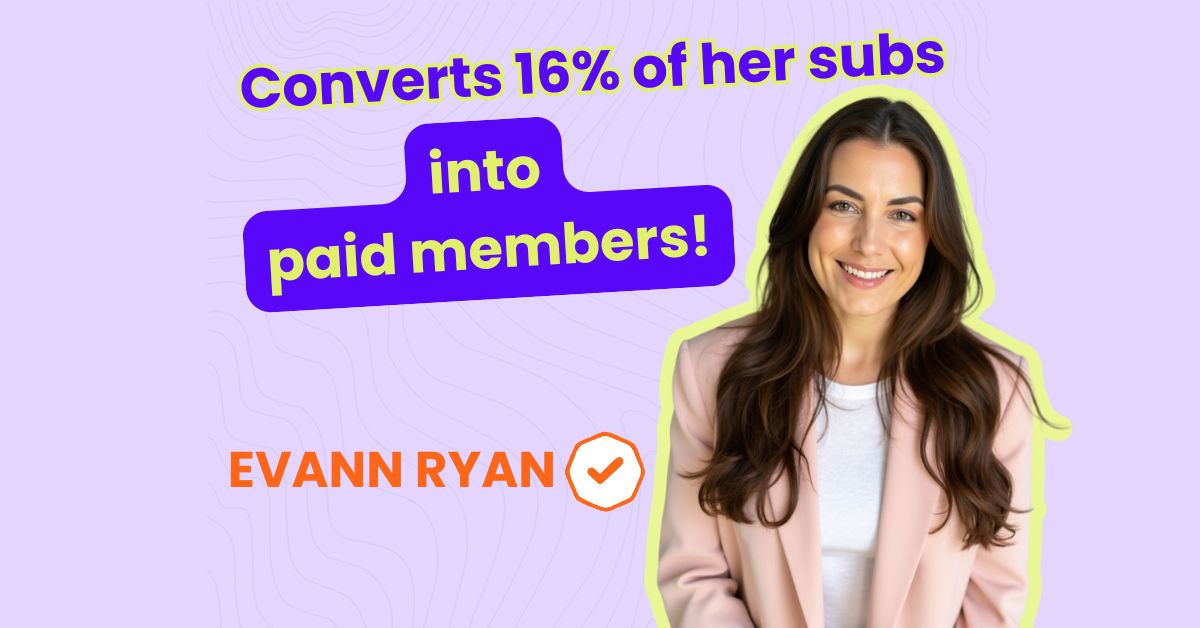Interview Date: January 08, 2023
Table of Content
- Newsletter Identity Card
- Meet CJ Gustafson
- Start of Mostly Metrics
- Newsletter Growth
- Most Impactful Growth Strategy
- Toolkit
- Weekly Newsletter Creation Process
- An Advice to Newsletter Creators
CJ Gustafson is the creator of Mostly Metrics, a newsletter about financial metrics and business models that reaches out to 14,000 subscribers!
CJ has been writing Mostly Metrics since Dec’20 every week. And he has written only for a few hundred subscribers during the first 1.5 years. Things changed after he decided to put his audience’s needs at the core and utilize a diverse set of clever tactics to distribute his content.
But, most importantly, he continued to show up and did what he love doing every week, no matter what.
Now, his audience is bigger than his hometown in his own words. 🙂
This impressive success can make you think that he is a full-time creator but you are wrong. He runs his newsletter while working as a full-time CFO.
What is more striking is the fact that Mostly Metrics made him land his dream CFO role in the first place.
Well, a lot to talk about, right? Let’s listen to CJ’s story from himself.
NEWSLETTER IDENTITY CARD
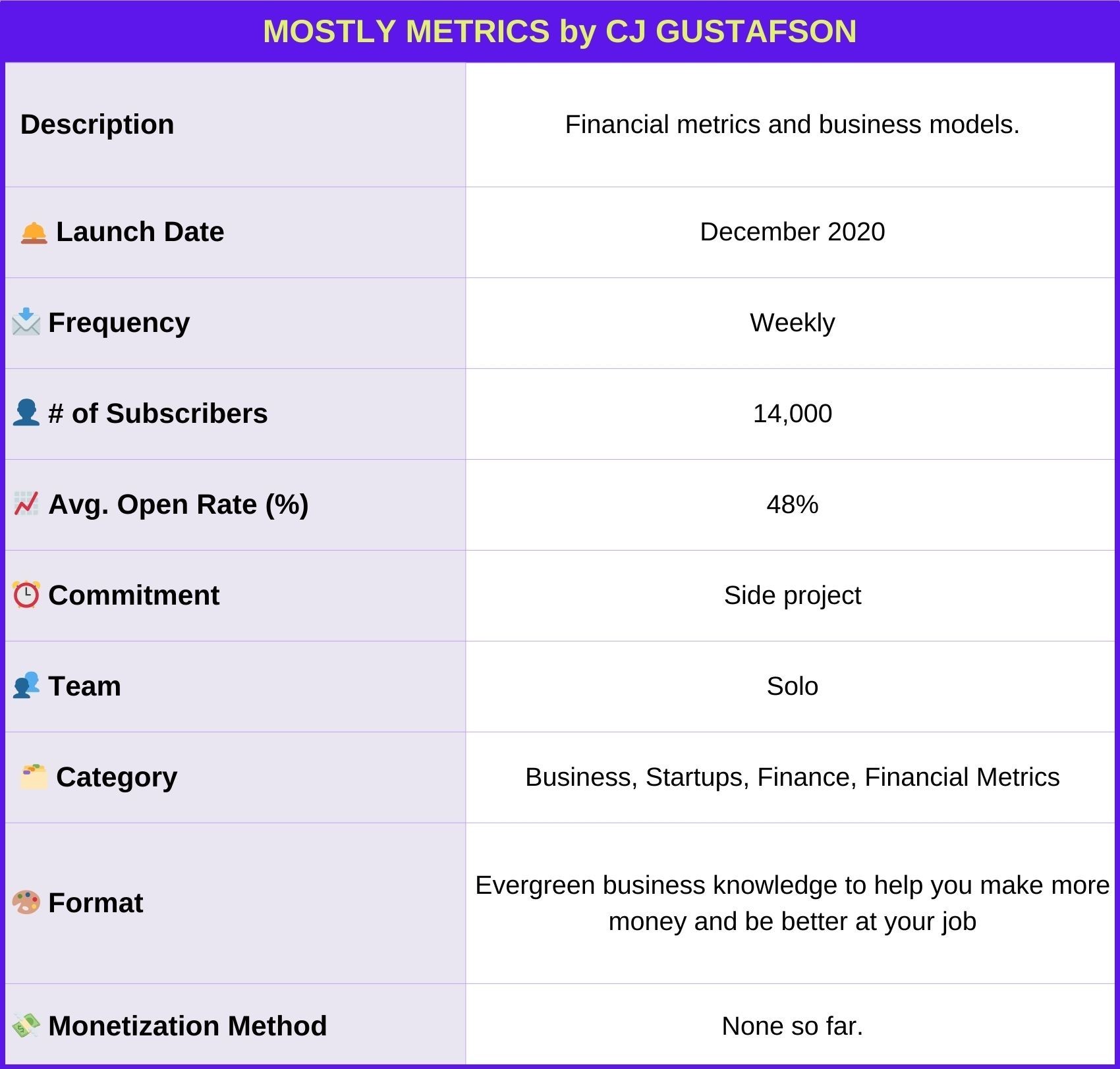
TOOL STACK
- ESP → Substack
- Design → Canva
- Design → PowerPoint
- Growth → Excel
MEET THE CREATOR
Hello CJ. Can you tell us about yourself?
Sure, I work as a CFO at a Series B tech company by day and write Mostly Metrics, a weekly business newsletter, by night.
I started my career in M&A consulting. I then did a stint in Private Equity. This is where I learned about software and technology businesses.
I then decided to go to the other side of the table and work for VC-backed companies, helping them grow fast and figure out how to allocate resources for the best results.
In terms of what I do for fun, I’m a bit of an adrenaline junkie. I was an amateur boxer in my younger years. I’ll do any sport with a board or tow rope. I’ve been yelled at by many of my bosses, and my wife and mom, for various injuries that made it harder to type.
How and why did you decide to start Mostly Metrics?
Sure, so I started the newsletter for three reasons:
- First, I felt like I was learning a ton at a hyper-growth company running FP&A. I didn’t want to forget everything that was coming my way. I wanted to document it and have a playbook for later.
- Second, I wanted an excuse to talk to really smart people. The newsletter allows me to discuss topics I’m interested in with VCs and startup founders, something that gets me really energized.
- And third, I just like writing. It helps me crystallize what I’m learning. The process is something I enjoy. You don’t have to pay me to write. It’s just something I like to do.
GROWTH
How did you reach 14,000 subscribers after staying stable for months? How did you make it in the end?
“I stopped writing about myself and started writing about the reader.”
There is a lot to mention. I explained my whole journey of building an audience and all key learnings along the way in the below thread.
What is the most impactful growth strategy?
Consistency. Showing up every week is 80% of the battle. People make you a part of their information diet.
“Writing good, or even great, stuff is important, but doing it over, and over, and over, and over, and over…and over again is the most important. Be relentless in content creation.”
Twitter has been cool for finding people to cross-promote with. I used to think Twitter was just a bunch of angry people in their mom’s basements (which it sometimes is) but I’ve met a lot of smart people and we’ve been able to help each other grow our audiences.
The other part that’s helped my growth is I don’t just recite the news. There are three types of content, in my opinion: aggregation (the news), editorial (opinion, humor, fascinating analyses), and educational (helps you make more money).
People care the most about the third because it will make them better, especially if it is very specific to a problem they are trying to solve for.
Do you monetize your newsletter?
No, not yet, but eventually I’d like to build a suite of software tools that help VCs and startup operators work together.
And I envision my newsletter being top of the funnel to help get the word out. The topics I talk about are at the intersection of the funding and the funded. So I think I can also help bridge the gap with software applications that help them communicate results and benchmark performance more effectively.
I also have ideas on how to help employees negotiate for their equity at startups. Stay tuned in the years to come.
Which tools do you use for which purposes to create your newsletter?
I use PowerPoint and Excel most of the time.
The hack to creating dope imagery in PowerPoint is to crank up the resolution for when you print to jpg or png. It took some minor coding to get done, but I’m sure you can google it. It makes business-like stuff look more like an artist’s stuff.
I also started using Canva for larger full-page graphics, but I’m still a white belt.
Why did you choose Substack?
They had the exact layout I was going to create on my own – a blog that is also a newsletter. They give you the best of both at once.
They also allowed me to use my own domain name, which was very important to me. I want to own my own SEO.
Finally, they are constantly innovating. The recommendation feature, which wasn’t there when I started, has been an absolute game-changer.
I’m also addicted to their reader app, as a consumer of the platform as well.
What is your typical weekly process from creation to sending a new issue?
I write 80% of an issue on Saturday or Sunday afternoon and then edit the last 20% during the week. I feel like you have to write when inspiration strikes you and then come back to it a number of times for short stints of pruning during the week.
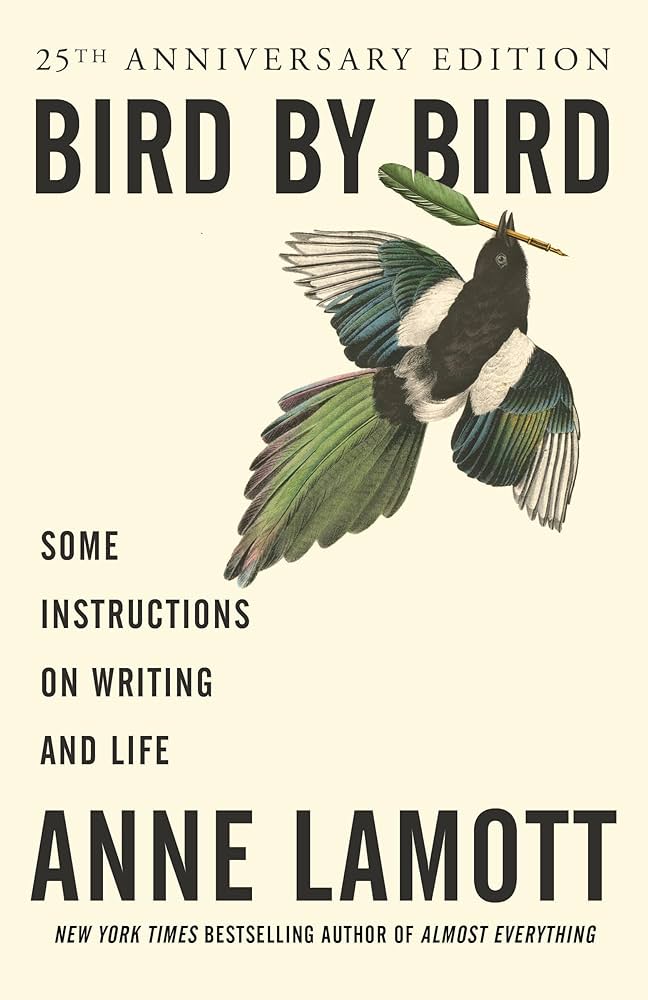
One of my favorite books is “Bird by Bird” by Anne Lamont. It’s about the writing process.
“At the end of the day, the writing process is both exhilarating and frustrating and like running in mud.”
How do you generate feedback and engage with your readers?
I DM a lot of smart people on Twitter and ask them questions that I include in “Mostly Experts” issues.
I have started using the Substack chat feature but haven’t built up a consistent rhythm yet. I have been surprised by how many people have answered though in the couple of times I’ve asked questions.
“Writing Mostly Metrics helped me land my first CFO gig and dream job at a high-growth tech company.”
How did this happen?
I was writing Mostly Metrics and it got me on the radar of a VC firm that was recruiting on behalf of their portfolio companies. So by putting myself out there, and writing about things I knew really well and was very passionate about, it helped get me on the radar of like-minded people.
I think they read my stuff and said wow this guy (nut) talks about financial metrics in his spare time. He’s passionate about the space.
How do you evaluate your life before & after Mostly Metrics?
Writing Mostly Metrics has given me a sort of superpower – people think I’m smarter than I am. And it’s just because I put myself out there and try to make complex stuff in the finance world simple. I’m really not smarter than readers. So I’m always blown away by some of the email addresses I see roll in.
You are a very good writer considering your unique tone of voice, how you integrate humor naturally and explain such complex topics in a simple way.
What is your relationship with writing? Did you have any experience before Mostly Metrics?
Writing was my favorite topic in school (yes, weird for a finance guy to say).
I also double majored in finance and history in college, because I loved writing essays. I was the editor and chief of my high school newspaper and wrote for the college paper as well. So writing has always been a part of my life.
What is the most challenging and the most rewarding part of writing a newsletter?
The most challenging part is the newsletter is always on my mind. I see everything I do now through the lens of “is this a newsletter topic?”. It’s a blessing and a curse.
You also built a job board for your audience. Could you please tell us about “Mostly Talent”? See here.
My newsletter audience is startup operators, financial analysts and VCs. VCs are always trying to hire smart people to work at and run their portfolio companies.
I saw a few other writers building job boards and realized that the financial analyst and “G&A” (general and administrative, or non-technical) part of the startup ecosystem was underserved for job boards. All the job boards seemed to be for engineers or product managers, and I said, hey, my audience could benefit from something like this too.
If you are a candidate looking for your dream job, check it out. And if you are a company that wants to hire people who think about Net Dollar Retention or CAC Payback Period every night before they go to bed, hit me up.
What is next on this journey?
Who knows. I think writing opens up a lot of avenues. It has already helped me get my dream job. And it makes me better at that job. I guess I’ll have to see where the pen takes me.
If you had the right to give one single piece of advice to aspiring newsletter creators, what would it be?
If you haven’t started writing because you are afraid of what people might think – remember that they don’t care. They only care about themselves. If anything, people won’t listen to you. Like, at all.
No one cared about me writing for over a year and a half. I’m talking about single-digit views on some pieces. So don’t pay others any mind, because they aren’t sitting at home waiting to see if you’ll write anything. You’ll probably have to jump up and down to get their attention anyways. Just go for it.
Are there any other newsletters that you followed?
Lot’s. My favorite newsletter to read on a daily basis is The Diff by Byrne Hobart. I have no idea how he knows so much about different areas of business. It’s humbling when you read people like him.
I also really like Liberty’s Highlights – he’s kinda positioned at the intersection of art and finance and science, which is my sweet spot in terms of interests.
You can check out my recommendations page on Substack for more.
Any final words?
“Reach out to at least one person outside your network monthly to talk.”
I started doing it because I felt my network was super insular to the startup world and I didn’t know any creators. I literally taped a piece of paper on the fridge and wrote down people’s names each month to keep myself honest.
Now, I talk to at least one creator a week, and it’s changed the way I spot opportunities in the world.


